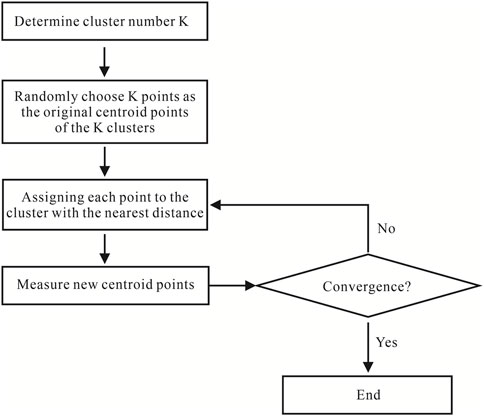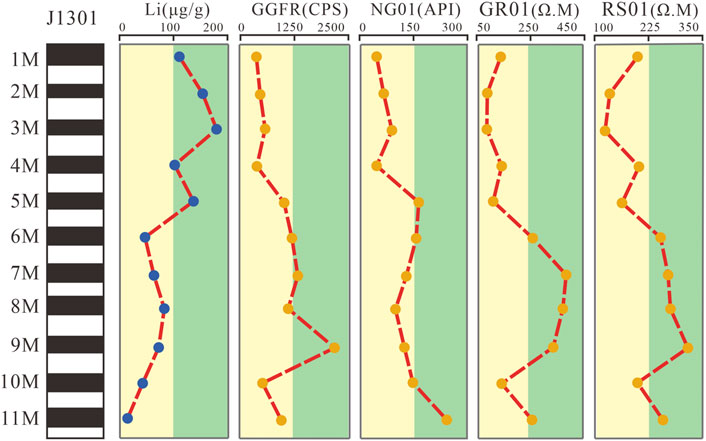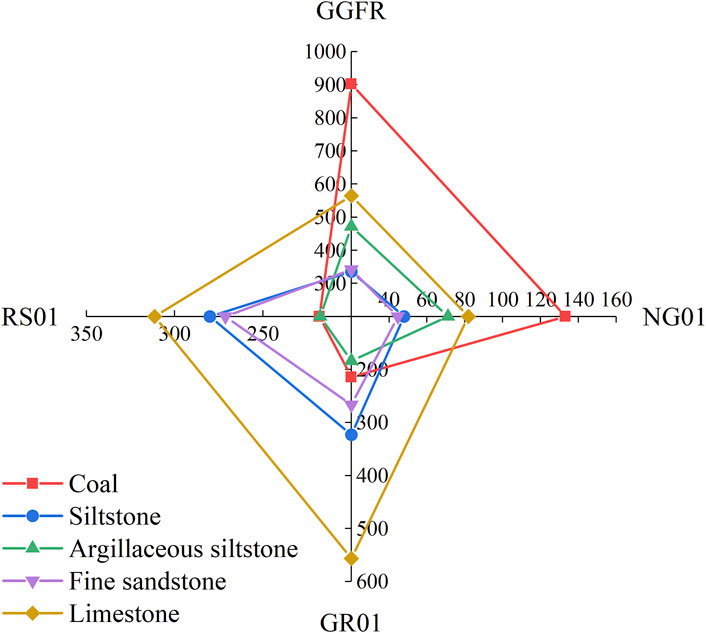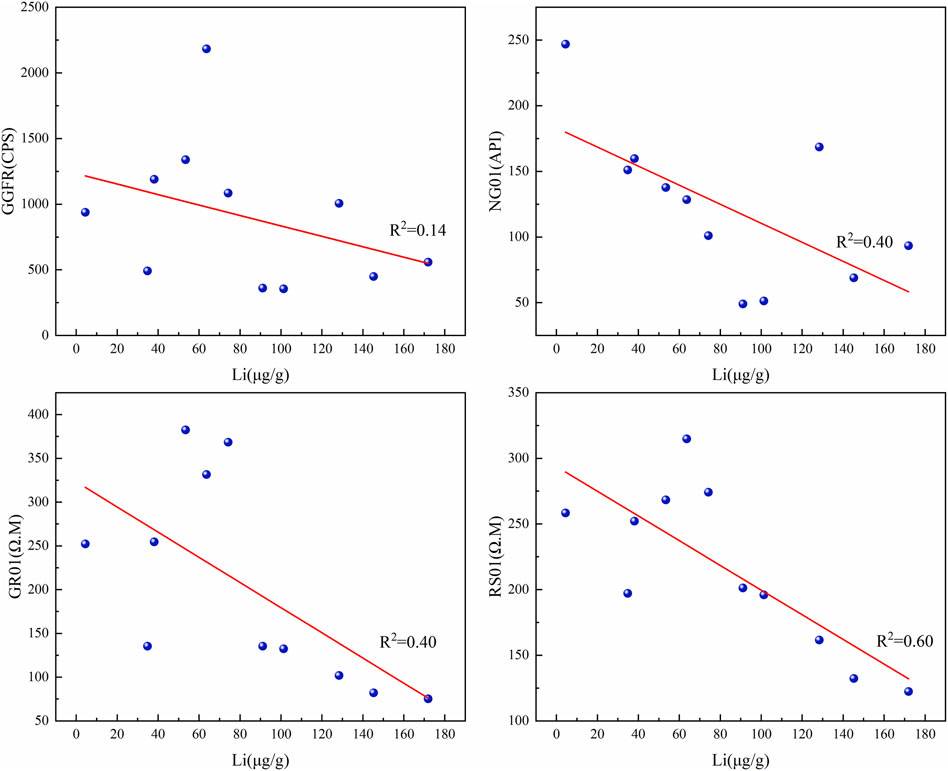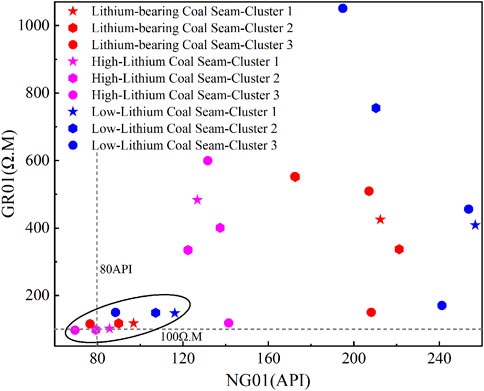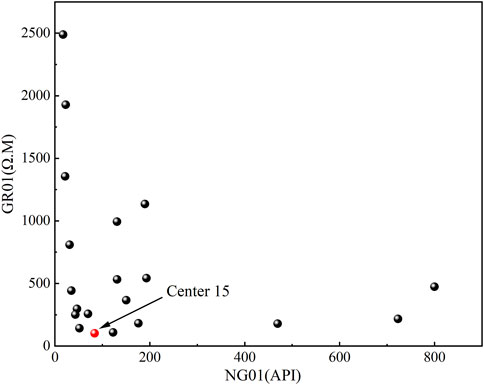- 1Key Laboratory of Coalbed Methane Resources and Reservoir Formation Process, Ministry of Education, China University of Mining and Technology, Xuzhou, China
- 2School of Resources and Geoscience, China University of Mining and Technology, Xuzhou, China
- 3Geological Exploration Research Institute, Guizhou Bureau of Coal Geological Exploration, Guiyang, China
- 4Guizhou Provincial Key Laboratory of Fluidized Mining of Coals, Guiyang, China
Lithium in coal, as a new type of associated mineral resource, has considerable potential for exploration. Exploration of high-lithium coal seams is essential for developing and using the associated lithium resources. To explore the distribution of lithium resources in the early stages of development in coal seams, the relationship between coal seam logging data and lithium content was analyzed by taking Guojiadi Coal Mine (China) as example. By analyzing the correlation between the different logging curves and the lithium content in coal and combining the K-means algorithm to identify the logging characteristics of different lithium-containing coal seams, we finally obtained the logging identification characteristics of high-lithium coal seams. The results reveal differences in the logging curves of coal seams with different lithium contents. The natural gamma and lateral resistivity of high-lithium coal seams are approximately 80 API and 100 Ω.M, respectively. Our study shows that the early identification of high-lithium coal seams can be evaluated from a logging perspective. We propose a preliminary identification method of high-lithium coal seam based on logging curve parameters by clustering analysis of borehole logging data to achieve accurate prediction.
1 Introduction
Lithium is a vital strategic metal that plays an important role in modern industry and new energy technology (Dai and Finkelman, 2018; Li et al., 2024). When the lithium content in coal exceeds a certain grade, lithium deposits associated with the coal can be formed as sedimentary lithium deposits (Zhao et al., 2022). Global lithium resources are plentiful, mainly distributed in North and South America. At the national level, lithium is distributed in the US, Australia, and China (Kesler et al., 2012; Ambrose and Kendall, 2020; Jiu et al., 2022). In recent years, European countries, Russia, South Africa, China, and other coal-producing countries have researched key metals such as lithium in coal and have successively discovered key metal deposits in the coal system (Dai et al., 2020). The development and use of associated lithium minerals in coal can be an important supplementary source of lithium resources, which is of great importance to the research and development of metal element mineral resources in coal. China is rich in coal resources. The enrichment of associated lithium has been found in coal in many regions of China, and the quantity of resources is considerable (Zhang et al., 2024). Western Guizhou is a crucial coal-producing area in southwest China. The main coal-bearing strata are in the Upper Permian Longtan Formation. Coal from multiple Late Permian coal-bearing basins in western Guizhou is highly enriched in critical metals (Liu et al., 2019; Liu et al., 2021), particularly lithium. Most research on associated lithium resources in coal has focused on the geochemical characteristics, occurrence status, enrichment sources, and mineralization rules of key metals in coal based on numerous samples (Hu et al., 2018; Tang et al., 2022). Nevertheless, few studies have focused on predicting lithium enrichment areas in coal.
In exploration and drilling, a series of logging activities are often carried out on the borehole. Conventional logging mainly includes natural gamma logging and resistivity logging. Logging data record stratigraphic information, geophysical parameters, and other related information, which is widely used in lithofacies identification, stratigraphic division, and other fields (Yan et al., 2018; Day-Stirrat et al., 2021; Lai et al., 2023). In addition, trace element-abnormal strata can be realized through a deeper interpretation of the logging data. Many scholars use different data processing methods, such as machine learning, neural networks, support vector machines, and other methods, to interpret logging data from multiple angles and successfully achieve different purposes, such as coal rock detection and coal facies discrimination (Puskarczyk et al., 2019; Hayat et al., 2020; Baudzis et al., 2021). With the rapid development of modern logging technology, a substantial amount of data are produced in the process of logging. Nevertheless, choosing the appropriate means to deal with huge amounts of data is particularly important. As a big data analysis method, clustering analysis is suitable for processing of massive data and can extract effective key information (Amjad and Chen, 2020). The K-means algorithm is important in clustering analysis. The algorithm is simple and efficient and can be applied to different analysis purposes by flexibly selecting the K value (Ikotun et al., 2023). Zhang et al. (2024) utilized K-means clustering for data preprocessing and accurately predicted reservoir porosity and permeability using conventional logging curves as input. Jing et al. (2021) selected different mechanical parameters of rock samples, analyzed geophysical logging data based on the K-means dynamic clustering method, and realized a lithology classification. Lai et al. (2024) also used the K-means algorithm to realize the automatic identification of lithology and evaluated the water saturation of shale reservoirs in combination with logging curves. However, few studies have focused on the identification of abnormally high-lithium concentrations in coal seams using logging data.
Therefore, the J1301 well of Guojiadi Coal Mine in Liupanshui Coalfield of Western Guizhou was taken as the research object, and the systematic logging was carried out to determine the lithium content. Using the K-means clustering algorithm, we combined the logging data with the lithium content in the coal seam to obtain the logging response characteristics of the high-lithium coal seam. The whole well-logging data are identified. It is hoped that high-lithium coal seams can be identified during coal seam exploration and drilling to provide theoretical guidance for the exploration and development of associated lithium mineral resources in coal.
2 Samples and methods
2.1 Sample collection
The Guojiadi Coal Mine is a part of the Liupanshui Coalfield (Figure 1A), which is located in the southeast wing of the Qingshan Syncline in Panxian County and Pu’an County, southwest of the Liupanshui Coalfield, Guizhou Province (China). The main axis of the Qingshan syncline is distributed in the NE-SW direction, with an inclination angle of 3°–25°. The southeast limb is locally steep, and secondary folds and faults in the NE–SW direction have developed on both limbs (Huang and Qu, 2021). The Liupanshui Coalfield is located in western Guizhou Province and is a set of marine-terrigenous coal-bearing deposits (Figure 1B). The paleogeography of coal accumulation is the long delta plain type, and the sedimentary environment is the upper and lower delta plains. The main sedimentary system is the delta sedimentary system. The sedimentary type is based on distributary channel deposition, including natural levees, crevasse fans, and interdistributary bays on both sides of the river channel. The transition zone between the upper and lower delta plains is the ideal location for coal accumulation, with the best coal-bearing properties (Bilal et al., 2023; Jamaluddin et al., 2023). Generally, there are many coal seams, with mainly medium–thick coal seams. The coal seams are widely distributed. The stability is good, and the ash and sulfur contents are low (Jiang et al., 2020).
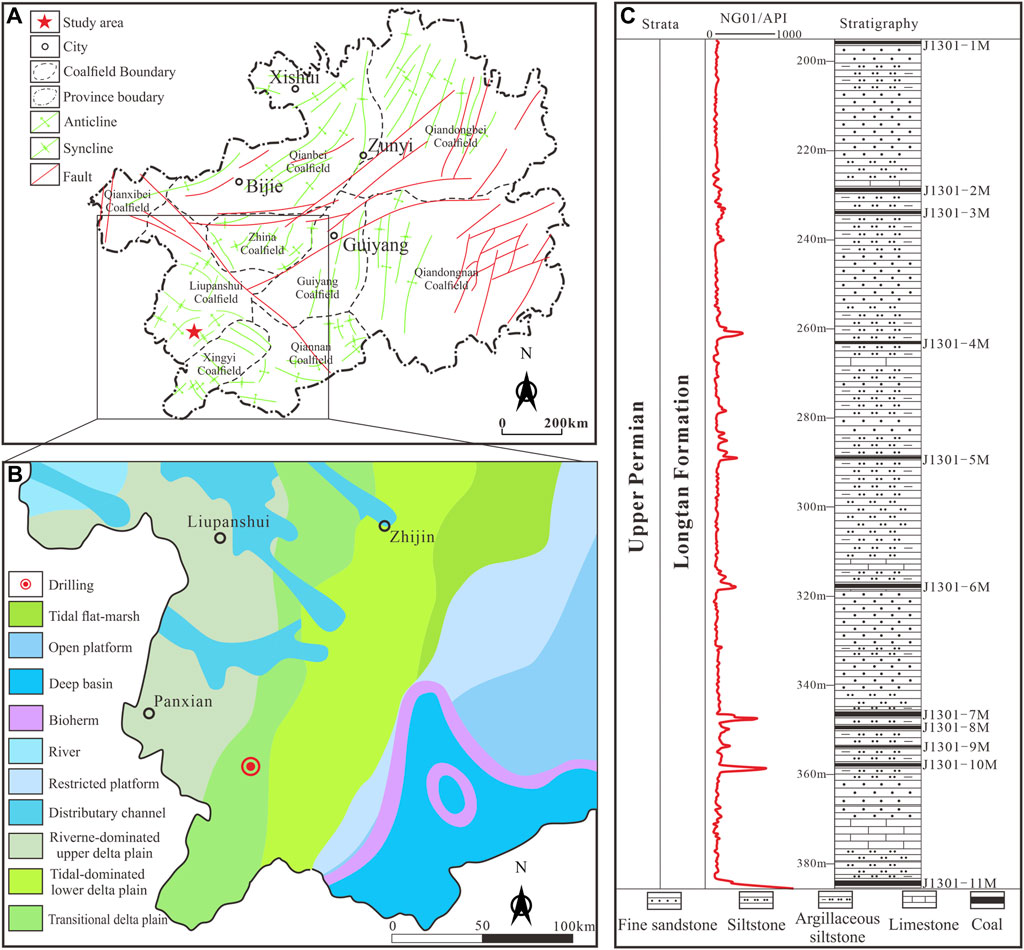
Figure 1. Location of well J1301 (A) Location of the study area; (B) Sedimentary environment of the study area; (C) Lithologic map of well J1301.
Well J1301 is located in the Guojiadi Coal Mine. The coal-bearing strata include coal seams No. 12, 17, 18, 20, 26, and 28, as well as a few thin coal seams. The coal seam has a thickness of 0.45–2.11 m and a depth of 196–383 m. The lithology of the whole borehole is mainly sandstone, including siltstone, argillaceous siltstone, fine sandstone, and limestone. All coal seam samples were collected during the drilling process and immediately stored bags to prevent contamination. The coal seams encountered during drilling were numbered 1M–11M from top to bottom (Figure 1C). Long-source distance gamma (GGFR), natural gamma (NG01), lateral resistivity (GR01), and apparent resistivity (RS01) logging were performed simultaneously.
2.2 Test methods
Lithium content was determined by inductively coupled plasma–mass spectrometry (ICP–MS, NEXION 2000-B, PerkinElmer, Inc.). The determination was conducted according to GB/T 14506.30–2010. Firstly, the sample is ground to a particle size of 200 mesh. The ICP-MS sample digestion method is as follows: precisely weigh 50 mg of coal sample ground to a particle size of 0.075 mm and transfer it into a PTEF digestion vessel. Subsequently, add HF and HNO3, seal the vessel, and heat it at a constant temperature of 190°C for 36 h. Once complete digestion is achieved, remove the sample and dry it thoroughly. Then, introduce 1 mL of HNO3 (1:1) at a temperature of 24°C followed by another drying step. Dissolve the salts using HNO3 (1:1) solution and subsequently add Rh internal standard solution (500 mg). Further addition includes 2 mL of HNO3 and 3 mL of deionized water before placing it back in the steel container for heating at 140°C for 5 hours. After cooling down, remove the digestion vessel, shake well, and transfer an aliquot volume of 0.4 mL into a centrifuge tube with subsequent adjustment to reach a final volume of 10 mL prior to instrument analysis.
The cluster analysis method is used to identify the logging characteristics of coal seams with different lithium contents. The core concept of cluster analysis is “birds of a feather flock together.” The algorithm classifies data objects separately based on the degree of similarity between them, which is an unsupervised learning method (Ahmed et al., 2020; Chen et al., 2020). The K-means clustering algorithm is often used in practice. K-means clustering is a fast, iterative process (Shahrivari and Jalili, 2016; Capó et al., 2017). Figure 2 illustrates the workflow of the K-means algorithm.
3 Results
3.1 Sample Li content and logging results
By conducting GGFR, NG01, GR01, RS01 logging in the J1301 well, and measuring the lithium content in the coal seam, we obtained the lithium content in Well J1301 and the average value of the corresponding log curves (Figure 3).
GGFR is a logging method used to obtain the formation density using the gamma photon counting rate received by the instrument. For different lithology strata, the scattering and absorption capacities of the gamma photons are different, and the count rates of gamma photons received by the detector are also different (Chen and Zhang, 2022). The GGFR value of coal seams ranges from 300 to 2700 CPS, with a mean of 900 CPS. The GGFR value of the lithium-rich coal seam is between 300 and 1350 CPS. NG01 is closely related to the ash content of coal but is generally to the organic matter composition or the humic acid content of coal (Gao et al., 2015). The NG01 values of coal seams range from 35 to 200 API, with an average of 133 API. The NG01 values of a lithium-rich coal seam are between 35 and 120 API. The GR01 curve is mainly affected by the sedimentary environment, original rock mineral composition, porosity, and cement. The electrical parameters of each lithology vary greatly (Duan et al., 2023). The GR01 value of coal seams ranges from 45 to 1300 Ω.M., averaging of 214 Ω.M. The GR01 value of a lithium-rich coal seam is between 50 and 200 Ω.M. Generally, the measured resistivity is called the apparent resistivity, RS01. The RS01 of coal seams ranges from 50 to 500 Ω.M, averaging 218 Ω.M. The RS01 of a lithium-rich coal seam is between 60 and 260 Ω.M. The lithium content in the coal seam of Well J1301 varies greatly, as shown in Figure 3.
The lithium content ranged from 4.46 μg/g to 171.93 μg/g, with a mean of 82.44 μg/g. It shows a certain regularity in the vertical direction, and the lithium content decreases from the upper coal seam to the lower coal seam. The coal seams from J1301-5 coal and above show different logging response characteristics from the coal seams below. The lithium content of the J1301-5 coal and above coal seams is above 90 μg/g. GGFR is between 300 and 600 CPS; NG01 is less than 100 API; GR01 is between 75 and 135 Ω.M, and RS01 is less than 200 Ω.M. The lithium content in the coal seam below the J1301-5 coal is below 90 μg/g. The GGFR range is 938–2183 CPS, and the fluctuation is large. The NG01 range is greater than 100 API. GR01 is greater than 250 Ω.M, and RS01 is greater than 250 Ω.M.
3.2 Well-logging characteristics
Radar maps of the logging characteristics of different lithologies are obtained by counting the logging characteristics of different types of lithology (Figure 4). The logging characteristics of coal are quite different from those of other lithologies. The GGFR and NG01 values of coal are much higher than those of fine sandstone and siltstone. They are also quite different from argillaceous siltstone and limestone. The RS01 of coal is similar to that of argillaceous siltstone and lower than that of limestone, siltstone, and fine sandstone. The GR01 of coal is larger than that of argillaceous siltstone and smaller than that of fine sandstone, siltstone, and limestone. The RS01 of coal is similar to that of argillaceous siltstone and lower than that of limestone, siltstone, and fine sandstone. The GR01 of coal is larger than that of argillaceous siltstone and smaller than that of fine sandstone, siltstone, and limestone. Compared with the logging characteristics of other lithologies, the logging characteristics of coal have specific identification characteristics. The well-logging data can be further identified by cluster analysis.
A scatter plot of the lithium content and different logging responses at the corresponding depths is drawn for correlation analysis (Figure 5). The lithium content strongly correlated with RS01, with R2 reaching 0.60. The lithium content shows the next highest correlation with NG01 and GR01 (R2 of 0.40). The correlation between the lithium content and GGFR is the lowest, with R2 of 0.14.
3.3 Cluster identification of high-lithium coal seams
K-means clustering analysis was performed on the J1301 well logging data using SPSS (Statistical Package for the Social Sciences) data analysis software to obtain the logging clustering center. Based on the lithium content in coal seams, coal seams are divided into high-lithium coal seams (lithium content >50 μg/g) and low-lithium coal seams (lithium content <50 μg/g) (Sun et al., 2014). Lithium-containing coal seams are the sum of high- and low-lithium coal seams. The overall logging characteristics of the lithium-bearing coal seam in Well J1301 in Guojiadi are as follows: GGFR = 901 CPS, NG01 = 133 API, GR01 = 214 Ω.M, RS01 = 218 Ω.M. K-means clustering was performed on the lithium-containing, high-lithium, and low-lithium coal seams, and the number of clusters was divided into 2, 3, and 4. Tables 1–3 list the clustering results.
The GGFR cluster center has a large fluctuation range, from 535 to 2503 CPS, but there is no apparent distinction in RS01. No similarity is observed in the different center point gaps for the different cluster numbers. A plot of the NG01 and GR01 (Figure 6) reveals some differences between the and low-lithium coal seams. The NG01 and GR01 of the high-lithium coal seam are approximately 80 API and 100 Ω.M, respectively. NG01 and GR01 of the low-lithium coal seam approximately 100 API and 150 Ω.M, respectively. Hence, high-lithium coal seams can be identified using the above indicators. K-means clustering is performed on the logging data of the J1301 well using the above values as the logging response characteristics of the well. A clustering center consistent with the target horizon appears when the clustering number is set to a higher value. The clustering results can be found in Tables 4, 5.
It can be found by clustering the whole-well data (Figure 7): NG01 of the cluster center of cluster 15 is 83 API, and the GR01 is 102 Ω.M, which is consistent with the aforementioned high-lithium target layer. The corresponding strata of cluster 15 are mapped individually, and a cluster prediction map is prepared. The high-lithium coal seams are comprehensively identified, and more lithium-containing layers are identified in the non-coal parts, as shown in Figure 8.
4 Discussion
Herein, lithium-bearing coal seams, high-lithium coal seams, and low-lithium coal seams were divided according to their lithium contents. Using statistical logging response characteristics, coal seams with different lithium contents were compared, and the logging response characteristics of the different lithologies were analyzed. NG01 and GR01 of the low-lithium coal seams were higher than those of the high-lithium coal seams. Some scholars have studied the logging response of coal seams in different regions and found that the gamma ray of coal is 20–50 cps, and the resistivity is 500–1200 Ω.M, which is different from the high-lithium coal seam in Guojiadi (Bhaskar, 2006; Chatterjee and Paul, 2013; Ghosh et al., 2016). The analysis of the high-lithium coal seam in Guojiadi shows that the high-lithium coal seam has a high gamma ray value and a low resistivity value.
The variation in lithium content can be essentially explained by the difference in physical characteristics between high-lithium and low-lithium coal seams. Lithium is generally hosted in clay minerals, and high-lithium coal seams tend to have higher clay mineral contents, which cause physical differences between seams, thus affecting the logging characteristics. This result may be due to the following reasons. 1) Lithium is generally found in clay minerals in coal, and we can obtain lithium information indirectly by analyzing the logging reflections of clay minerals in coal. When the clay content is high, the lithium content in coal tends to be higher than that in coal seams with lower clay content (Li et al., 2023). Clay minerals tend to show lower gamma responses in the gamma logs because their content is usually low, and as fine granular materials, they exist in tiny particles in reservoirs such as coal seams. Therefore, the peak value of clay minerals in NG01 logging curves is usually low, and the NG01 signal may be weak compared to other common minerals (such as quartz and feldspar) (Ehsan and Gu, 2020; Jiang, 2021). 2) Common minerals such as quartz and feldspar usually have high electrical conductivity, so they will show higher values in the resistivity logs. However, clay minerals contain relatively more water and salt plasmas, resulting in lower lateral resistivity (Han and Misra, 2018; Zhao et al., 2019). Many scholars have also pointed out that coal has a wide range of gamma ray response, especially when some thin coal seams are mixed with surrounding rocks, which will make some coal seams have a higher gamma ray response. This may lead to incorrect predictions of high-lithium coal seams when using cluster analysis methods (Keskinsezer, 2019; Yusefi and Ramazi, 2019).
A cluster center consistent with the target layer appears when the whole-well logging data are clustered and the number of clusters is set to a higher value. This result may be due to the following reasons. 1) From the perspective of the K-means clustering algorithm principle, setting different cluster numbers will have different effects on the clustering results. An increase in the number of clusters leads to an increase in the number of cluster centers, and the distance between each cluster center will increases. A larger number of clusters can better separate different clusters. 2) From a practical perspective, rocks with different lithologies will be encountered as the drilling depth increases. These rocks have experienced different sedimentary and diagenetic processes, and the corresponding logging characteristics will differ. A higher clustering number can classify rocks of different lithologies more accurately. At the same time, we also need to consider other factors, such as the depth of the coal seam and its thickness, which will affect the identification of high-lithium coal seams. This increases the uncertainty of identification (Antariksa et al., 2022).
The relationship between well-logging curves and lithium content was obtained by analyzing and summarizing the responses of well-logging curves of different types of coal seams in high-lithium areas. The response characteristics of the logging curves of coal seams with different lithium contents differed. For NG01 and GR01, there are still similar cluster centers when different cluster numbers are set. This shows that coal seams with different lithium contents are also significantly different, and this center can be used as a basis for identifying high-lithium coal seams. The well-logging curves were clustered and compared with the aforementioned high-lithium coal seam clustering centers. High-lithium coal seam clustering data were distributed throughout the well. Hence, the data of the whole well can be identified using this method, not just limited to a specific range, and some high-lithium coal seams can be identified with high accuracy.
In connection with reality, lithium exists in coal seams, and may also be enriched in other rocks, such as roof and floor plates (Dai and Finkelman, 2018). In the clustering, a high-lithium coal seam clustering center exists in the coal seam, and is distributed widely in other lithologies, which is consistent with the above. The trace element content cannot be determined directly from the logging curves because they only reflect the physical, chemical, and petrological characteristics of the formation. However, by analyzing the logging response characteristics of coal seams, coal seams with different lithium contents can be distinguished and used as criterion. This means that the early identification of high-lithium coal seams can be evaluated from the perspective of logging. The possibility of trace elements and their content range can be inferred from a comprehensive analysis of the whole logging data and other geological data. Further experimental analysis is required to confirm the existence and content of trace elements.
5 Conclusion
The lithium content in the Guojiadi Coal Mine is high, averaging 82.44 μg/g, which is much higher than the international lithium content in coal and is highly representative. The lithium content in the coal seam is strongly correlated with the RS01, GR01, and NG01 logging curves. Coal seams with different lithium contents have different logging characteristics. The NG01 and GR01 values of high-lithium coal seams are approximately 80 API and 100 Ω.M, respectively. The NG01 and GR01 values of low-lithium coal seams are approximately 100 API and 150 Ω.M, respectively. Hence, high-lithium coal seams can be identified by performing K-means clustering on the natural gamma and lateral resistivity logs of the entire drilling well and comparing the log characteristics of regional high-lithium coal seams. The k-means clustering method is used to identify high-lithium coal seams in Guojiadi Coal Mine. Although there are some wrong classifications of high-lithium coal seams, the differential analysis of different lithium-bearing coal seams and the rapid identification of high-lithium coal seams are the main contributions of this work. Most importantly, this study shows that the early identification of high-lithium coal seams can be evaluated from a logging perspective.
Data availability statement
The original contributions presented in the study are included in the article/supplementary material, further inquiries can be directed to the corresponding author.
Author contributions
XM: Conceptualization, Data curation, Funding acquisition, Supervision, Writing–original draft. YZ: Conceptualization, Methodology, Supervision, Writing–review and editing. KD: Funding acquisition, Supervision, Writing–review and editing. YS: Data curation, Software, Writing–original draft. MH: Data curation, Software, Writing–original draft.
Funding
The author(s) declare that financial support was received for the research, authorship, and/or publication of this article. This work was financially supported by the National Natural Science Foundation of China (42172156), the Fundamental Research Funds for the Central Universities (2022YCPY0201), and the National Key R&D Program of China (No. 2020YFA 0711800).
Acknowledgments
Thanks to the Key Laboratory of Coalbed Methane Resources and Reservoir Formation Process and the Guizhou Provincial Key Laboratory of Fluidized Mining of Coals for all the support provided to this study.
Conflict of interest
The authors declare that the research was conducted in the absence of any commercial or financial relationships that could be construed as a potential conflict of interest.
Publisher’s note
All claims expressed in this article are solely those of the authors and do not necessarily represent those of their affiliated organizations, or those of the publisher, the editors and the reviewers. Any product that may be evaluated in this article, or claim that may be made by its manufacturer, is not guaranteed or endorsed by the publisher.
References
Ahmed, M., Seraj, R., and Islam, S. (2020). The k-means algorithm: a comprehensive survey and performance evaluation. Electronics-Switz 9 (8), 1295. doi:10.3390/electronics9081295
Ambrose, H., and Kendall, A. (2020). Understanding the future of lithium: Part 1, resource model. J. Ind. Ecol. 24 (1), 80–89. doi:10.1111/jiec.12949
Amjad, A., and Chen, S. (2020). Characterization of well logs using K-mean cluster analysis. J. Pet. Explor. Prod. Te. 10 (6), 2245–2256. doi:10.1007/s13202-020-00895-4
Antariksa, G., Muammar, R., and Lee, J. (2022). Performance evaluation of machine learning-based classification with rock-physics analysis of geological lithofacies in Tarakan Basin, Indonesia. J. Petrol Sci. Eng. 208, 109250. doi:10.1016/j.petrol.2021.109250
Baudzis, S., Karłowska-Pik, J., and Puskarczyk, E. (2021). Electrofacies as a tool for the prediction of true resistivity using advanced statistical methods—case study. Energies 14 (19), 6228. doi:10.3390/en14196228
Bhaskar, G. (2006). Electro lithofacies analysis for depositional history and stratigraphy of Manuguru coalfield using geophysical well logs. J. Ind. Geophys. Union 10 (3), 241–254.
Bilal, A., Yang, R., Lenhardt, N., Han, Z., and Luan, X. (2023). The Paleocene Hangu formation: a key to unlocking the mysteries of Paleo-Tethys tectonism. Mar. Petrol. Geol. 157, 106508. doi:10.1016/j.marpetgeo.2023.106508
Capó, M., Pérez, A., and Lozano, J. A. (2017). An efficient approximation to the K-means clustering for massive data. Knowl-Based Syst. 117, 56–69. doi:10.1016/j.knosys.2016.06.031
Chatterjee, R., and Paul, S. (2013). Classification of coal seams for coal bed methane exploitation in central part of Jharia coalfield, India – a statistical approach. Fuel 111, 20–29. doi:10.1016/j.fuel.2013.04.007
Chen, J., Zhang, J., Wu, J., Wu, Y., Si, H., and Lin, K. (2020). Review on the research of K-means clustering algorithm in big data. ICECE, 107–111. doi:10.1109/icece51594.2020.9353036
Chen, S., and Zhang, Y. (2022). Cluster analysis logging curve method for lithology classification of coal-bearing strata. Inn. Mong. Coal Econ. 07, 22–24. doi:10.3969/j.issn.1008-0155.2022.07.009
Dai, S., and Finkelman, R. B. (2018). Coal as a promising source of critical elements: progress and future prospects. Int. J. Coal Geol. 186, 155–164. doi:10.1016/j.coal.2017.06.005
Dai, S., Zhao, L., Wei, Q., Song, X., Wang, W., Liu, J., et al. (2020). Resources of critical metals in coal-bearing sequences in China: enrichment types and distribution. Chin. Sci. Bull. 65, 3715–3729. doi:10.1360/tb-2020-0112
Day-Stirrat, R. J., Hillier, S., Nikitin, A., Hofmann, R., Mahood, R., and Mertens, G. (2021). Natural gamma-ray spectroscopy (NGS) as a proxy for the distribution of clay minerals and bitumen in the Cretaceous McMurray Formation, Alberta, Canada. Fuel 288, 119513. doi:10.1016/j.fuel.2020.119513
Duan, Z., Xiao, K., Yang, Y., Huang, X., Wang, D., Xu, Y., et al. (2023). Logging identification of borehole lithology of sandstone-type uranium deposit in Songliao Basin. Prog. Geophys. 38 (6), 2490–2501. doi:10.6038/pg2023hh0120
Ehsan, M., and Gu, H. (2020). An integrated approach for the identification of lithofacies and clay mineralogy through Neuro-Fuzzy, cross plot, and statistical analyses, from well log data. J. Earth Syst. Sci. 129 (1), 101. doi:10.1007/s12040-020-1365-5
Gao, J., Fu, X., Liu, A., and Luo, P. (2015). Logging response prediction of 15# coalbed coal quality parameters in Heshun area Qingshui Basin. J. Xi`an Univ. Sci. Technol. 35 (01), 50–55. doi:10.13800/j.cnki.xakjdxxb.2015.0109
Ghosh, S., Chatterjee, R., and Shanker, P. (2016). Estimation of ash, moisture content and detection of coal lithofacies from well logs using regression and artificial neural network modelling. Fuel 177, 279–287. doi:10.1016/j.fuel.2016.03.001
Han, Y., and Misra, S. (2018). Joint petrophysical inversion of multifrequency conductivity and permittivity logs derived from subsurface galvanic, induction, propagation, and dielectric dispersion measurements. Geophysics 83 (3), D97–D112. doi:10.1190/geo2017-0285.1
Hayat, U., Ali, A., Murtaza, G., Ullah, M., Ullah, I., Celis, A., et al. (2020). Classification of well log data using vanishing component analysis. Pure Appl. Geophys. 177 (6), 2719–2737. doi:10.1007/s00024-019-02374-2
Hu, P., Hou, X., Zhang, J., Li, S., Wu, H., Damø, A. J., et al. (2018). Distribution and occurrence of lithium in high-alumina-coal fly ash. Int. J. Coal Geol. 189, 27–34. doi:10.1016/j.coal.2018.02.011
Huang, W., and Qu, Z. (2021). CBM occurrence characteristics and suggestions for exploration and development in digua exploration area of baotian qingshan block in Guizhou. China Coalbed Methane 18 (02), 30–35. doi:10.3969/j.issn.1672-3074.2021.02.008
Ikotun, A. M., Ezugwu, A. E., Abualigah, L., Abuhaija, B., and Heming, J. (2023). K-means clustering algorithms: a comprehensive review, variants analysis, and advances in the era of big data. Inf. Sci. 622, 178–210. doi:10.1016/j.ins.2022.11.139
Jamaluddin, , Wagreich, M., Gier, S., Schöpfer, K., and Battu, D. P. (2023). Sedimentary environments and paleoclimate control of the middle miocene balikpapan group, lower kutai basin (Indonesia): implications for evaluation of the hydrocarbon potential. Minerals-Basel 13 (10), 1259. doi:10.3390/min13101259
Jiang, F., Bi, W., and Wang, S. (2020). Study on natural gamma border detection technology for horizontal wells geosteering. Contemp. Chem. Ind. 49 (1), 121–124. doi:10.3969/j.issn.1671-0460.2020.01.030
Jiang, Y. (2021). Analysis of sedimentary environment and coal accumulation regularity of late permian coalfields in Guizhou. Shandong Coal Sci. Technol. 39 (10), 158–161. doi:10.3969/j.issn.1005-2801.2021.10.055
Jing, J., Ke, S., Li, T., and Wang, T. (2021). Energy method of geophysical logging lithology based on K-means dynamic clustering analysis. Environ. Technol. Inno. 23, 101534. doi:10.1016/j.eti.2021.101534
Jiu, B., Huang, W., and Mu, N. (2022). Mineralogy and elemental geochemistry of Permo-Carboniferous Li-enriched coal in the southern Ordos Basin, China: implications for modes of occurrence, controlling factors and sources of Li in coal. Ore Geol. Rev. 141, 104686. doi:10.1016/j.oregeorev.2021.104686
Keskinsezer, A. (2019). Determination of coal layers using geophysical well-logging methods for correlation of the Gelik-Zonguldak and Kazpınar-Amasra (Bartin) coalfields, Turkey. Geomech. Geophys. Geo-energ. Geo-resour. 5, 223–235. doi:10.1007/s40948-019-00105-4
Kesler, S. E., Gruber, P. W., Medina, P. A., Keoleian, G. A., Everson, M. P., and Wallington, T. J. (2012). Global lithium resources: relative importance of pegmatite, brine and other deposits. Ore Geol. Rev. 48, 55–69. doi:10.1016/j.oregeorev.2012.05.006
Lai, F., Liu, Y., Tan, X., Wang, R., Peng, S., and Gao, X. (2024). A composite water saturation model of continental mixed shale oil reservoirs based on complex lithology identification. Geol. J. 59 (4), 1401–1415. doi:10.1002/gj.4934
Lai, J., Wang, G., Fan, Q., Zhao, F., Zhao, X., Li, Y., et al. (2023). Toward the scientific interpretation of geo-physical well logs: typical misunderstandings and countermeasures. Surv. Geophys. 44 (2), 463–494. doi:10.1007/s10712-022-09746-9
Li, J., Liu, L., Kang, X., Li, K., Zhang, S., and Liu, Q. (2023). Enrichment of lithium in the claystone coal gangue from the malan mine, xishan coalfield, shanxi Province, northern China. Geochemistry-germany 83 (2), 125972. doi:10.1016/j.chemer.2023.125972
Li, X., Wei, Y., Cao, D., Wei, J., Liu, X., Zhang, Y., et al. (2024). Cooperative exploration model of coal–lithium deposit: a case study of the haerwusu coal–lithium deposit in the jungar coalfield, inner Mongolia, northern China. Minerals-Basel 14 (2), 179. doi:10.3390/min14020179
Liu, J., Dai, S., Song, H., Nechaev, V. P., French, D., Spiro, B. F., et al. (2021). Geological factors controlling variations in the mineralogical and elemental compositions of Late Permian coals from the Zhijin-Nayong Coalfield, western Guizhou, China. Int. J. Coal Geol. 247, 103855. doi:10.1016/j.coal.2021.103855
Liu, J., Song, H., Dai, S., Nechaev, V. P., Graham, I. T., French, D., et al. (2019). Mineralization of REE-Y-Nb-Ta-Zr-Hf in wuchiapingian coals from the Liupanshui coalfield, Guizhou, southwestern China: geochemical evidence for terrigenous input. Ore Geol. Rev. 115, 103190. doi:10.1016/j.oregeorev.2019.103190
Puskarczyk, E., Jarzyna, J. A., Wawrzyniak-Guz, K., Krakowska, P. I., and Zych, M. (2019). Improved recognition of rock formation on the basis of well logging and laboratory experiments results using factor analysis. Acta geophys. 67 (6), 1809–1822. doi:10.1007/s11600-019-00337-8
Shahrivari, S., and Jalili, S. (2016). Single-pass and linear-time k-means clustering based on MapReduce. Inf. Syst. 60, 1–12. doi:10.1016/j.is.2016.02.007
Sun, Y., Zhao, C., Li, Y., and Wang, J. (2014). Minimum mining grade of the selected trace elements in Chinese coal. J. China Coal Soc. 39 (4), 744–748. doi:10.13225/j.cnki.jccs.2013.1718
Tang, B., Fu, Y., Yan, S., Chen, P., Cao, C., Guo, C., et al. (2022). The source, host minerals, and enrichment mechanism of lithium in the Xinmin bauxite deposit, northern Guizhou, China: constraints from lithium isotopes. Ore Geol. Rev. 141, 104653. doi:10.1016/j.oregeorev.2021.104653
Yan, J., He, X., Hu, Q., Liang, Q., Tang, H., Feng, C., et al. (2018). Lower Es3 in Zhanhua Sag, Jiyang Depression: a case study for lithofacies classification in lacustrine mud shale. Appl. Geophys. 15 (2), 151–164. doi:10.1007/s11770-018-0678-5
Yusefi, A., and Ramazi, H. (2019). ProxInLAS, a software program for detecting coal layers and estimating parameters of layers, using geophysical well-logs. Earth Sci. Inf. 12, 415–427. doi:10.1007/s12145-019-00382-3
Zhang, J., Wang, R., Jia, A., and Feng, N. (2024). Optimization and application of XGBoost logging prediction model for porosity and permeability based on K-means method. Appl. Sci. 14 (10), 3956. doi:10.3390/app14103956
Zhang, W., Zhao, L., Wang, W., Nechaev, V. P., French, D., Graham, I., et al. (2024). Enrichment of critical metals (Li, Ga, and rare earth elements) in the early Permian coal seam from the Jincheng Coalfield, southeastern Qinshui Basin, northern China: with an emphasis on cookeite as the Li host. Ore Geol. Rev. 167, 105939. doi:10.1016/j.oregeorev.2024.105939
Zhao, J., Zhang, L., Li, S., Li, Z., Niu, Z., and Guo, X. (2019). Research on the prediction method of shale clay mineral and quartz content in the Z area of Taihang. Prog. Geophys. 34 (2), 0681–0686. doi:10.6038/pg2019cc0075
Keywords: lithium, high-lithium coal seam, logging curve, logging response, cluster analysis, Kmeans algorithm
Citation: Mu X, Zhu Y, Dou K, Shi Y and Huang M (2024) Logging response prediction of high-lithium coal seam based on K-means clustering algorithm. Front. Earth Sci. 12:1443458. doi: 10.3389/feart.2024.1443458
Received: 04 June 2024; Accepted: 05 August 2024;
Published: 15 August 2024.
Edited by:
Zhengguang Zhang, China National Administration of Coal Geology (CNACG), ChinaReviewed by:
Xiaowei Hou, Hefei University of Technology, ChinaJunjian Zhang, Shandong University of Science and Technology, China
Ang Liu, The Pennsylvania State University (PSU), United States
Copyright © 2024 Mu, Zhu, Dou, Shi and Huang. This is an open-access article distributed under the terms of the Creative Commons Attribution License (CC BY). The use, distribution or reproduction in other forums is permitted, provided the original author(s) and the copyright owner(s) are credited and that the original publication in this journal is cited, in accordance with accepted academic practice. No use, distribution or reproduction is permitted which does not comply with these terms.
*Correspondence: Yanming Zhu, eW02M3pAY3VtdC5lZHUuY24=
 Xiwei Mu1,2,3,4
Xiwei Mu1,2,3,4 Kailong Dou
Kailong Dou